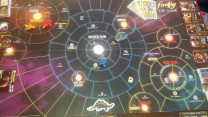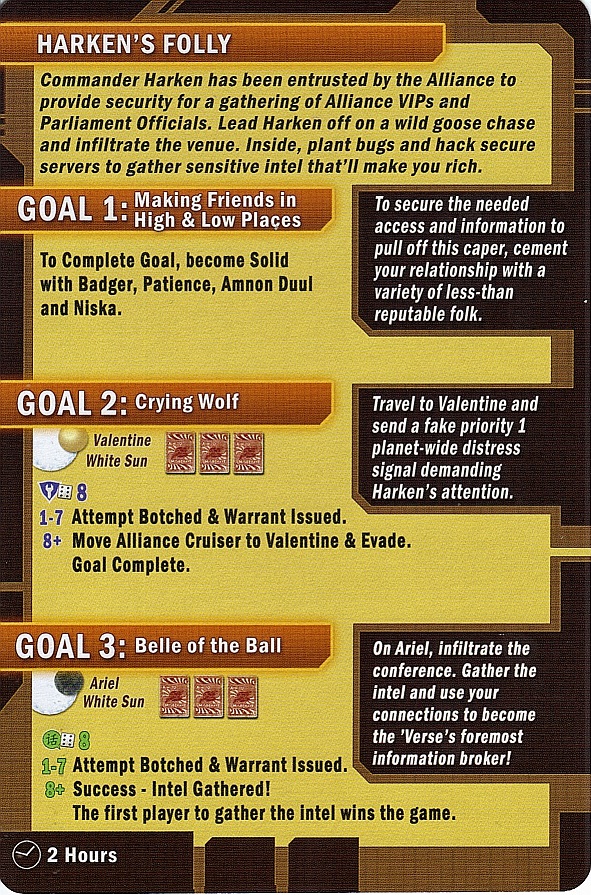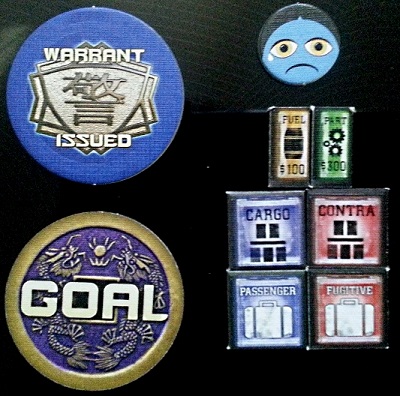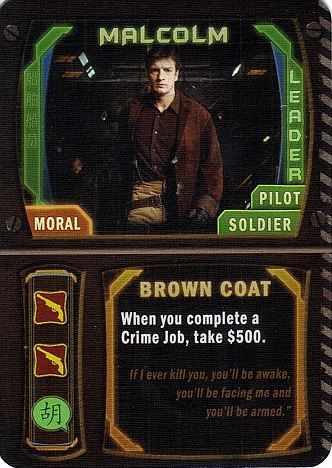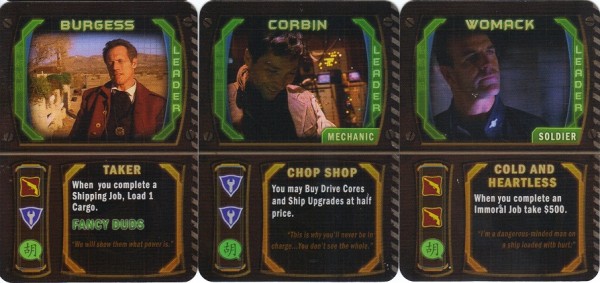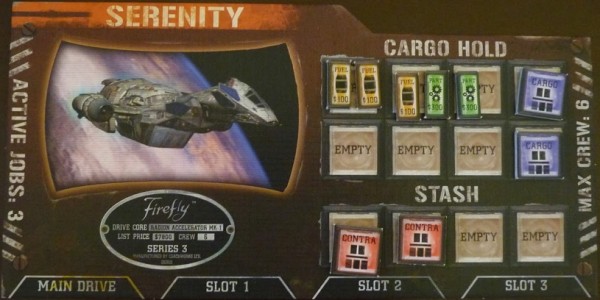Firefly: The Game is fairly nuanced and features a wieldy rulebook. To aid new players in making sense of things, or to give potential buyers a substantially in-depth look at how it plays, this is a comprehensive four-part guide on everything a player should know.
Introduction
Since this is meant as more of a supplement than a replacement, I’d always recommend looking at the rulebook first (available in PDF form online) to get a general idea of how the game functions. However, this guide will be covering all the basics and accounting for any updates from the official FAQ. Plus, everything explained here follows a logical progression and makes use of examples along the way, so anyone who wishes to dive right in hopefully shouldn’t become too lost.
It can make for quite a hefty read, but you’ll be well-versed in the ‘Verse when it’s done. So let’s get started…
FIND A CREW, FIND A JOB, KEEP FLYING
The game itself is designed around this saying, but for every game there will be a ‘Story Card’ that provides the scenario and an ultimate goal, or set of goals, towards which players will be working. I would encourage first-time players to familiarise themselves with the game using the replacement recommended starter scenario ‘First Time in the Captain’s Chair’ that was posted online by the designers. It plays relatively quickly and covers most of the basics. Otherwise, the solo game ‘Awful Lonely in the Big Black’ is good for owners wishing to learn the game ahead of a multiplayer session. The current Story Cards as well as the new introductory one can be found here.
‘First Time in the Captain’s Chair’ is a basic Story Card. Here’s an example of a more complex one.
Both probably look Chinese to you (oh, I’m so funny…) but worry not, once we’ve gone through everything, this will all make perfect sense.
Here’s a quick (and low quality – sorry!) picture of the tokens involved in the game, so they’ll be in mind when we refer to something later on.
Most are pretty self-explanatory because the text is right on there. It’s worth pointing out that Warrant Issued and Goal are two sides of the same token; the same goes for Cargo/Contraband and Passenger/Fugitive. That blue frowny face (aka. Fruity Oaty Bar face) in the top-right is known as a Disgruntled token. These are used whenever we need to show that characters are a little upset (yes, really).
And this here is the board (an endgame shot, courtesy of Jason Pounsett and a very close game).

On here, we have a couple of player ships (orange and blue) as well as the Reaver Cutter (red ship) and the Alliance Cruiser (grey). The Alliance Cruiser’s movement is limited to within that big blue circle, known as Alliance Space, while the Reavers can move everywhere outside of that circle in what is known as Border Space.
If we look closer, we can see system names (White Sun, Red Sun, Georgia, etc.) as well as all the little planets and some tabs that tell us where Job Contacts or Supply Planets are found. We’ll be referring back to this later on, so again, we shouldn’t fret if not everything seems clear.
ACTIONS
During a turn, we can perform up to 2 Actions from a choice of 4 different types. Actions are required for doing pretty much everything in the game, from buying to flying, and the same Action cannot be repeated during a single turn. Before we go any further, we’ll run through the different types.
Fly – This is how we’re going to get around the ‘Verse. We’ll cover the finer details after we’ve looked at the Ships and Navigation.
Buy – This the Action we use for hiring Crew and purchasing Gear and other items, as well as Fuel and Parts. Alternatively, if at a Supply Planet, we can forfeit our ability to buy anything in order to take ‘Shore Leave’. This costs $100 per Crew member and lets us remove all Disgruntled tokens; though we must pay for all Crew members, including our Leader, in order to do this, whether they are Disgruntled or not.
Deal – This Action is required to consider and accept Jobs from Contacts. If we’ve built a Solid Reputation with them, we may also sell them any Cargo and Contraband we have while Dealing with them.
Work – This Action must be undertaken to perform Jobs, even if it’s a simple Pick-Up of Cargo. It’s worth noting that if we don’t have any official Jobs, we can still use this Action to ‘Make Work’ in any sector that contains a planet and earn ourselves $200.
Interacting with other players (trading, hiring away Disgruntled crew) counts as a free Action on our turn, though these can’t be made midway through another Action and can only be done between players who are at a Full Stop in the same sector, i.e. if we flew over to another player and traded but didn’t travel our full movement range, we can’t continue that Fly Action.
Because we’re limited to just those 2 Actions, it’s important to try and maximise what we do with them. If we don’t, then other players may find the opportunity to get ahead.
A simple example would be if we were at a Supply Planet (one where we find Crew, Gear and other items) and had just used a Buy Action as our first that turn, but don’t wish to Fly off, for one reason or another (we’ll see a few different ones later on) and have no Contacts present with which to Deal, or we simply don’t want or need to. We can use that spare Action for ‘Make Work’ (under Work) and earn $200. It’s not much but, with this, perhaps we can then afford more Fuel or had already been eyeing up something we couldn’t Buy the first time round (and not always because we lacked funds).
I know that probably sounds confusing, as there are a lot of factors we haven’t yet covered, but rest assured, everything will be much clearer by the end.
LEADERS
OK, here we have our captain, or ‘Leader’. There are seven different Leaders, each with their own skills and attributes, but to begin with, let’s just take a look at the most familiar and well-known: Malcolm, herein referred to as Mal.
Besides the picture of him looking so very pretty, we have a fair few things on this card. The first one we’ll look at is that strip of icons towards the left of the bottom-half. Now, these are Skill Points. They come in three flavours: Fight, Negotiate and Tech, and generally relate to Skill Tests (which we’ll get to later on). The red and yellow icon with the gun stands for, you’ve guessed it, Fight, while that green speech bubble is Negotiate. What this tells us is that Mal can handle himself in a fight and can have some way with words if needed, but lacks any significant technical skill. Any Job he’s on, he brings along 2 Fight Skill Points and 1 Negotiate Skill Point by default.
Next up, those green tabs on the bottom-right of the portrait. These are his Professions. Nearly all characters will have one type of Profession, and in rare cases, even two. Mal, having fought in The Unification War, has the expertise of a Soldier, and having some desire to captain his own ship, learnt enough to become a Pilot. These labels don’t mean much on their own, but some Jobs may offer a small bonus for Crews containing a particular type of Profession, or there are special instances where some of these may apply (during navigation, Misbehaves, or in order to use Gear). Filling out our Crew with as many diverse Professions as possible can come in very handy.
And on the bottom-left of the portrait, we have the orange ‘Moral’ label. Not all characters are as ‘upstanding’ as Mal, and in some ways, it hurts to have such scruples. Within the game, we can find ‘Immoral Jobs’. Whenever these are completed, any Moral Crew on our Ship become Disgruntled, whether they directly Worked the Job or not. To represent this, we put one of those aforementioned frowny face tokens on their card. One Disgruntled token can be worrying as it means our non-Leader Crew are now able to be hired away by other players (a free Action on their turn, if we recall), while gaining a second token will immediately send that character back to the relevant Supply Planet discard pile (giving other players another opportunity to snatch them up). In Mal’s case, since a Leader doesn’t quit and can’t be hired away, a second Disgruntled token would see him fire every single member of his Crew. We’ll clarify a few things and talk more on the implications of Disgruntled Crew and Leaders in a little bit, but it’s something to keep in mind when looking at Jobs marked as Immoral, along with other circumstances that may cause ‘disgruntlement’.
Lastly, onto that title ‘Browncoat’ and the text underneath. All Leaders will have some form of special bonus skill/attribute, and most Crew will, too. In Mal’s case, as we can see, he earns a little extra money for completing Crime Jobs. Some tend to grant more significant bonuses (or general gameplay-altering characteristics) but this isn’t to be sniffed at.
If we look at a few of the other Leaders, we’ll notice some other things.
As we can see, none of these fine gentlemen are ‘Moral’, and Corbin brings along a new Profession with ‘Mechanic’, as well as providing some form of Tech Skill Points as signified by the blue spanner icon. All Leaders have some combination of the 3 types of Skill Points.
Also, we may notice that Burgess is, in fact, lacking a Profession. However, as a form of compensation or balance, he is wearing what most would consider some mighty, fine clothes, or ‘Fancy Duds’ as shown below his special ability. These fall under the category of Keywords, of which there are a few different types. Like the various Professions, these may offer extra opportunities at certain points, but can also fulfil Job Needs and other requirements. Keywords differ to Professions in that they can be found on Gear as well as Crew, but it still goes to say that it might prove helpful to get our hands on a few of these whenever possible.
Each Leader has their own strengths that we can play to (Mal and Crime Jobs, for example) but that is not essential. In fact, it’s more important to look out for their shortcomings, and find Crew and Gear to round out those Skill Point totals alongside the Professions and Keywords. Mal and Womack would benefit from someone with Tech Skill Points or finding some gadgets, Corbin will most likely want someone with Fight Skill Points or to buy some form of weapon.
Finally, it is worth mentioning that Leaders count as Crew for instances where this is mentioned (Ship space limits, Shore Leave, etc.). However, they differ in a few ways:
– Leaders are essentially players’ respective avatars and are self-employed, therefore, meaning that they don’t take a cut from Jobs (but could be said to take whatever profit is left).
– Leaders can’t be killed, instead they receive a Disgruntled token. Should this happen during a Work Action, they also return to the Ship, taking any Gear they had equipped with them; which means all Skill Points they were contributing would be gone from the current attempt.
– Whether from escaping death or Mal’s objection to Immoral Jobs, if a Leader ever receives a second Disgruntled token, they immediately fire all Crew (but retain any Gear they may have been carrying), sending them back to the appropriate discard piles. With this newfound peace of mind, the Leader will return to their original state with no Disgruntled tokens.
SHIPS
Now that we’ve taken the first step towards setting ourselves up in business, we’ll need a Ship, and there’s nothing that balances cost, flexibility and reliability like a Firefly-class.
As well as a little plastic piece to represent our place on the board, we get our own Ship Card. Below is Serenity herself. (Big thanks to Jason Pounsett for this image, too!)
Like the Leader cards, these are dense with information. First up, running down the right-hand side we see a note that the Ship can hold 6 Crew members (including Leaders in that limit). The intention is for Crew to be kept lined up to the right of this card (with space for Gear below them). We may dismiss any Crew we don’t want as a free Action when stopped at any planet, but should also stay aware that we may find Ship Upgrades that will allow us to increase this limit if need be.
Next, along the bottom, we see the Main Drive slot as well as 3 for Ship Upgrades. If we look at the identification plate (with the Firefly designation) this tells us that this Ship’s Drive Core is a Radion Accelerator Mk-1. This isn’t found among the Supply Planet decks, but instead from a separate deck with identical Drive Cores for all Ships and carries the same ‘You Can’t Take The Sky From Me’ blue-and-white card back as Leaders. This default Drive Core allows us to travel a maximum of 5 sectors (board spaces) when in Full Burn mode, or to Mosey just 1 sector. We’ll go into the finer details of Navigation in the next section.
If we ever buy a new Drive Core from a Supply Planet, we should ensure we’re perfectly happy with it, as the default one is removed from the game since it has no Supply Deck from which it can be repurchased. Of course, some players may wish to house-rule some sort of ‘buy-back’ value and process. If Ship Upgrades are replaced, they aren’t sold but simply discarded back into the appropriate deck (for others to purchase, potentially).
And round to the left, is the space for placing down Active Jobs. Jobs only become Active when the first step is started – i.e. the first Work Action is used – regardless of what the outcome is (there may be cases where we’re instructed to Misbehave but find our Attempt is Botched). Otherwise, Inactive Jobs are kept in-hand/face-down and secret from other players.
Lastly, we have the Cargo Hold and Stash, and we can see examples of the sorts of things that can be stored in those; just in case it’s not clear, nothing can be stacked. Fuel and Parts occupy just half a square, but can be combined as shown. Fuel is needed in order to maximise our movement, while Parts will mainly help if we suffer a Breakdown during movement. Both can be replenished at Supply Planets (of which there are 5), with the values shown on the tiles themselves, and can also be discarded at any time.
Cargo, Contraband, Passengers, and Fugitives (not shown) all take up a whole square but can be arranged however we wish. Though, it is generally a good idea to keep our Contraband and Fugitives in the Stash. It won’t stop them being seized if we run directly into the Alliance Cruiser, but there are other Alliance-related stops/inspections on Nav Cards from which they will stay hidden. As it is with Crew limit, Cargo and Stash space can also be increased with certain Ship Upgrades, and that extra space can come in handy for certain Jobs. Either way, it’s a good idea to reserve a little space for Fuel and Parts, especially in case of emergencies.
And from where might those emergencies arise? While navigating the ‘Verse, of course! In Part 2, we’ll be covering that along with Outlaw Ships and Skill Tests.
For gaming codes, check out borderlands 3 shift codes.
- Firefly: The Game – Starter’s Guide, Part 1 – Basics, Leaders, Actions & Ships
- Firefly: The Game – Starter’s Guide, Part 2 – Navigation, Outlaws & Skill Tests
- Firefly: The Game – Starter’s Guide, Part 3 – Contacts, Solid Rep, Jobs & Misbehaving
- Firefly: The Game – Starter’s Guide, Part 4 – Supply Planets & Supplies
